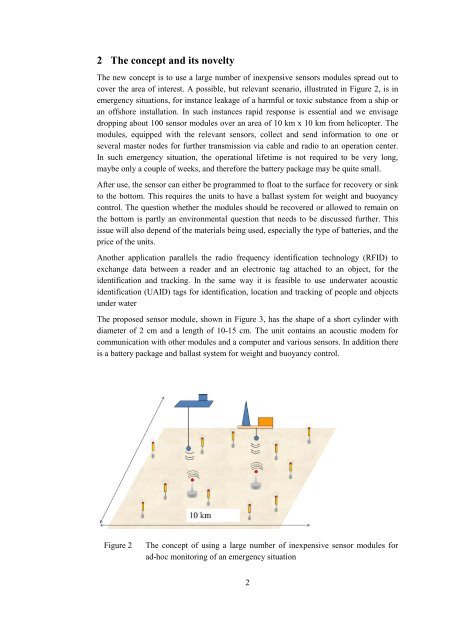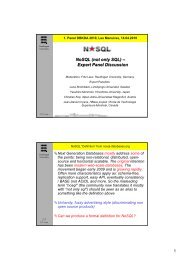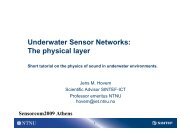Jens M. Hovem - iaria
Jens M. Hovem - iaria
Jens M. Hovem - iaria
You also want an ePaper? Increase the reach of your titles
YUMPU automatically turns print PDFs into web optimized ePapers that Google loves.
2 The concept and its novelty<br />
The new concept is to use a large number of inexpensive sensors modules spread out to<br />
cover the area of interest. A possible, but relevant scenario, illustrated in Figure 2, is in<br />
emergency situations, for instance leakage of a harmful or toxic substance from a ship or<br />
an offshore installation. In such instances rapid response is essential and we envisage<br />
dropping about 100 sensor modules over an area of 10 km x 10 km from helicopter. The<br />
modules, equipped with the relevant sensors, collect and send information to one or<br />
several master nodes for further transmission via cable and radio to an operation center.<br />
In such emergency situation, the operational lifetime is not required to be very long,<br />
maybe only a couple of weeks, and therefore the battery package may be quite small.<br />
After use, the sensor can either be programmed to float to the surface for recovery or sink<br />
to the bottom. This requires the units to have a ballast system for weight and buoyancy<br />
control. The question whether the modules should be recovered or allowed to remain on<br />
the bottom is partly an environmental question that needs to be discussed further. This<br />
issue will also depend of the materials being used, especially the type of batteries, and the<br />
price of the units.<br />
Another application parallels the radio frequency identification technology (RFID) to<br />
exchange data between a reader and an electronic tag attached to an object, for the<br />
identification and tracking. In the same way it is feasible to use underwater acoustic<br />
identification (UAID) tags for identification, location and tracking of people and objects<br />
under water<br />
The proposed sensor module, shown in Figure 3, has the shape of a short cylinder with<br />
diameter of 2 cm and a length of 10-15 cm. The unit contains an acoustic modem for<br />
communication with other modules and a computer and various sensors. In addition there<br />
is a battery package and ballast system for weight and buoyancy control.<br />
Figure 2<br />
The concept of using a large number of inexpensive sensor modules for<br />
ad-hoc monitoring of an emergency situation<br />
2
















